Accuracy in SEO tools is crucial because it directly impacts strategy, budgeting, and decision-making. Reliable data helps marketers allocate resources effectively, identify growth opportunities, and forecast results.
This article examines how accurate SEMrush really is across various metrics, including traffic estimates, keyword volumes, and backlinks. While SEMrush remains one of the most comprehensive SEO tools available, its data should be viewed as directional rather than absolute.
The platform provides strong trend insights and comparative benchmarks but may show variations from real analytics data. Used wisely, SEMrush delivers valuable guidance for SEO planning and competitive analysis.
How SEMrush Collects & Models Data
Explain SEMrush’s data sources: clickstream, SERP scraping, and keyword databases.
In order to understand how accurate SEMrush is, one needs to understand the data sources of SEMrush. To give you a basic overview of current SEMrush data: it has 27 billion keywords, 800 million domains, 43 trillion backlinks, 500 TB of raw website traffic data, and 100 million AI-related data points, making it the top SEO tool in the market.
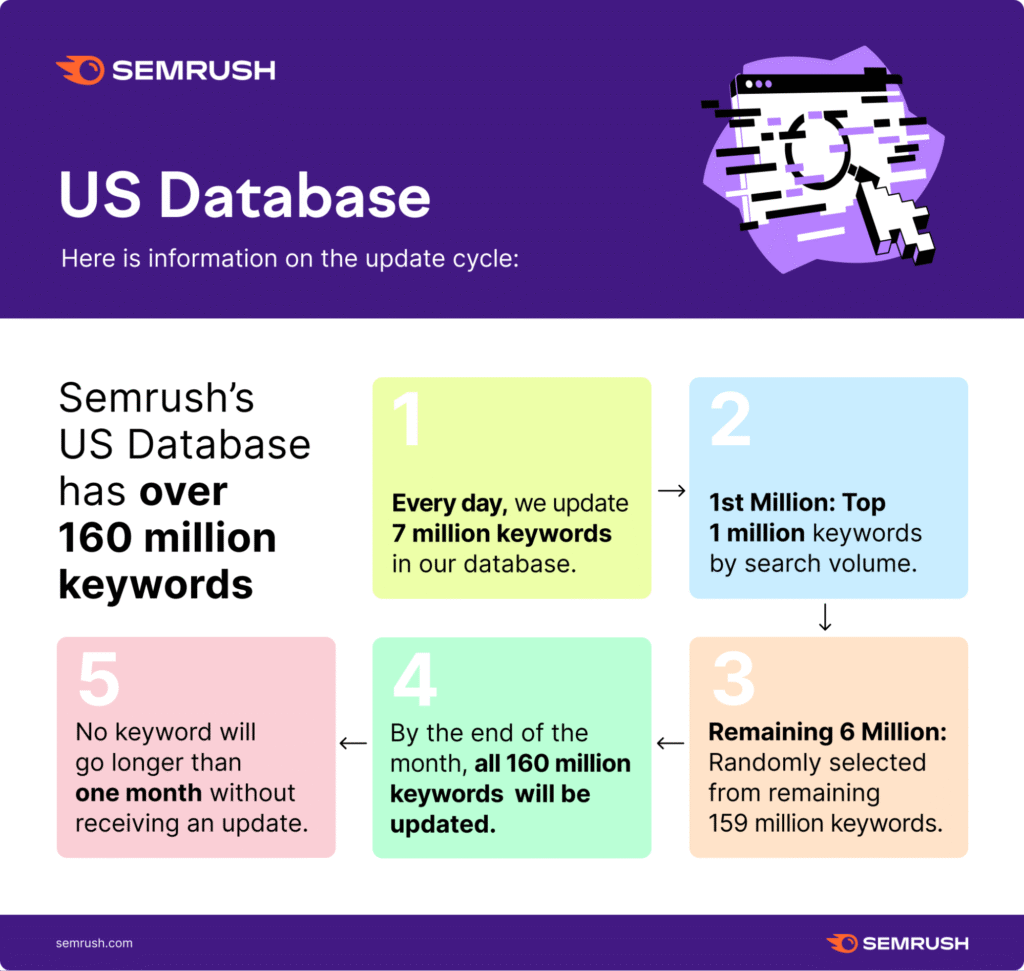
SEMrush uses the latest and up-to-date methods to collect data and present it in the most trusted and accurate format. For keywords and search engine rankings, they partner with third-party data providers like Clickstream to collect Google search engine pages for millions of keywords. SEMrush studies both organic and paid search results to give users a complete picture of any website’s visibility on Google.
Besides, SERP scraping is also a method that SEMrush uses. It involves scanning Google’s search results to track keyword rankings, featured snippets, and position changes across millions of queries. The keyword database is made from billions of keywords that are collected over time and updated regularly as per search trends.
By using these sources and techniques, SEMrush creates one of the largest SEO datasets, which helps SEO experts and marketers analyze, track, and improve their search marketing efforts.
How data modelling and sampling affect accuracy
Because SEMrush is a third-party tool, it cannot directly access Google’s or any other search engine’s private data. It uses statistical modelling, data sampling, and other third-party tools to estimate metrics like search volume, competition, traffic, and keyword difficulty.
These models extrapolate from observed patterns in Clickstream data and adjust for variables like country, device, and industry.
Sampling makes sure that the tool remains scalable but can introduce variance, especially for keywords with low search volume or small websites with minimal traffic.
SEMrush also uses machine learning algorithms to refine its datasets over time to reduce bias and improve trend detection. However, this also means that the data is directional rather than exact.
Why estimation errors occur (regional bias, device mix, panel limitations)
Since SEMrush is a third-party tool, data errors and mistakes are common. Also, no SEO tool can give 100% accurate data. Estimation errors in SEMrush arise because of limitations in data coverage and sampling methods. Clickstream data may also not be equal across all regions, leading to regional bias.
For example, data shown in North American and European countries is more accurate compared to smaller markets. The device mix can also skew results if desktop and mobile users are treated differently in certain industries.
Besides, panel limitations mean SEMrush depends on data from a subset of internet users, which may not completely reflect total search activity. While these factors highlight data accuracy gaps, SEMrush compensates with normalization techniques and continuous recalibration. Because of this, the accuracy is high for trend analysis and keyword comparison but less precise for exact traffic counts and niche keywords.
Cite SEMrush documentation on methodology
According to the official documentation of SEMrush, they collect data from multiple sources and keep updating it using advanced machine learning algorithms. Their keyword database is updated monthly, while traffic data is recalibrated with a verified Clickstream partnership.
SEMrush openly says that its metrics are estimates and not 100% accurate, as they are derived from aggregated data designed to reflect relative performance rather than exact figures. The documentation also mentions measures taken by SEMrush to improve their models, enhance coverage, provide better data to users, and reduce bias.
This transparency allows users to interpret SEMrush’s data realistically as a reliable, comparative tool for SEO research and competitive benchmarking.
Traffic Estimates: What SEMrush Shows vs. Reality
Overview of SEMrush’s traffic analytics tool

The organic traffic tool of SEMrush is a perfect tool for those who want to check the organic traffic of any website. One just needs to enter the name of the domain, and you will get the entire report of the website traffic.

SEMrush shows the countrywise traffic, cost of traffic from paid advertisements, branded and non-branded traffic, organic traffic from desktop and mobile, traffic trends, and a lot more.
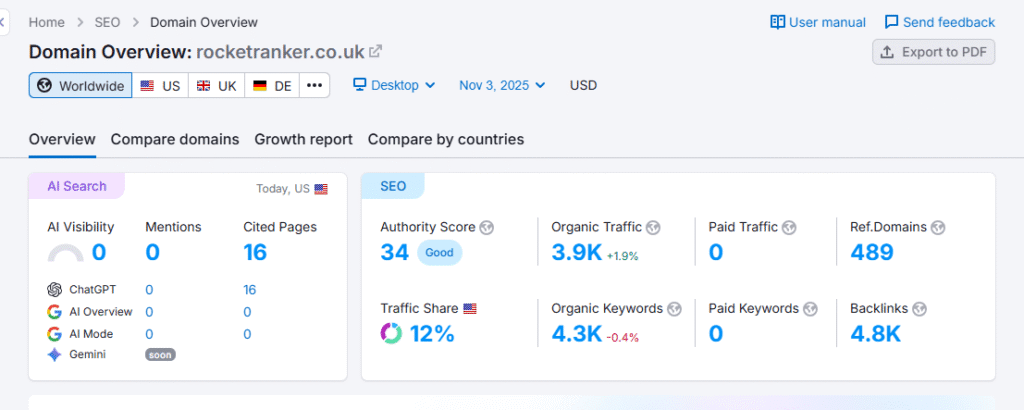
In the above-seen image, the total organic traffic for the website Rocket Ranker is showing as 3.9k. To check if the SEMrush data for organic traffic is accurate or not, we will compare the organic traffic data of Rocket Ranker from Google Analytics.

From Google Analytics, we found that the total organic traffic received on Rocket Ranker for the month of October was around 900, which was way too less than what we can see in the SEMrush organic traffic report.
The reason for this is that SEMrush might often overestimate or underestimate the data that it shows. So, which data should the user take into consideration for SEO? According to us, users can take both data points into consideration. At Rocket Ranker, we generally depend on the data of SEMrush and Ahrefs and completely believe in it.
Besides, there are many benefits of using SEMrush’s organic traffic data.
The tool’s biggest strength lies in its ability to uncover market trends and relative performance rather than providing exact traffic counts. For businesses without access to competitors’ analytics, SEMrush’s Traffic Analytics serves as a powerful benchmarking tool, giving a data-driven perspective on market share, visitor behavior, and growth opportunities across industries.
Independent findings: SEMrush often overestimates traffic for high-volume sites, underestimates smaller ones
By reading reviews, articles, and taking opinions from experts, we personally found that SEMrush traffic estimates tend to be directionally correct but numerically off.
Many reviews comparing SEMrush’s data with more accurate sources like Google Analytics or Google Search Console reveal that SEMrush overestimates the traffic data for larger and high-volume websites like e-commerce sites with 10,000 URLs and web pages due to their higher visibility in Clickstream panels, which SEMrush uses for collecting data.
On the other hand, it shows less traffic data for small or niche sites because they have fewer data points in their sample set. For example, a major news site might appear to have 20% more traffic than actually shown in its Google Analytics, while a small business website could show 30–40% less traffic.
This difference stems from the limited representation of smaller domains in SEMrush’s Clickstream sources. However, many people still feel that SEMrush data is more accurate, and that is the reason why they are still in the market.
Example comparison: SEMrush vs Google Search Console and GA4
Now, let us compare SEMrush traffic data with Google Analytics and Google Search Console for our personal website, which is Rocket Ranker.

In the above image, you can see that SEMrush shows 4k of total organic traffic that our site is getting.
Now let us check how much Google Analytics shows for the same site.

The total organic traffic from Google Analytics for the same website is around 1000, which is very less compared to what we get on SEMrush.
Now let us check the Google Search Console and analyze the organic traffic by checking how many clicks the website has got in the previous month.
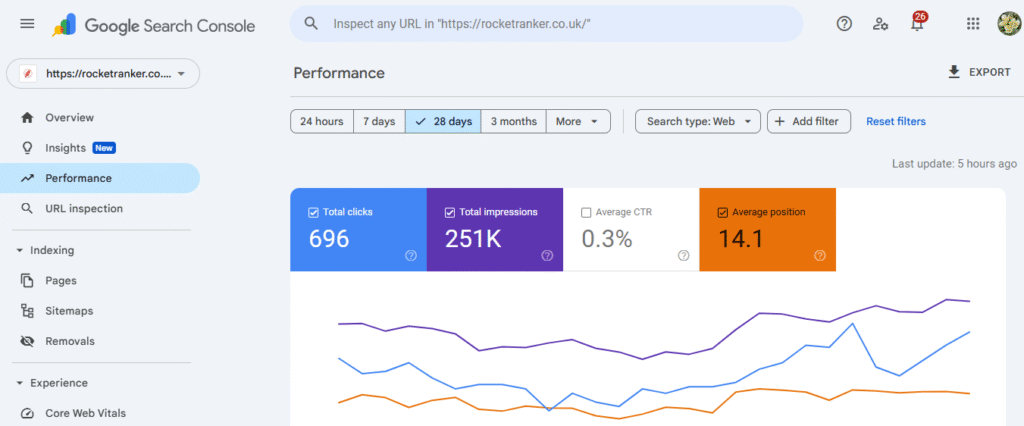
From the Google Search Console data, we know that the website has received around 700 clicks in the past 28 days. Hence, we can conclude that Google Analytics and Search Console data is more accurate and reliable compared to SEMrush.
The reason for this is that SEMrush picks its data from third-party sources, while Google Analytics and Search Console place tracking code on the website, which gives more accurate and real data.
Takeaway: reliable for trend and competitor comparison, not for exact numbers
By doing complete research and reviewing the tool with data and real sites, we found that SEMrush does not give accurate data when it comes to checking the organic traffic of a site.
Rather, it gives a close estimation of the traffic received by a website. The major strength of SEMrush, while checking for traffic, lies in the trends, patterns, and competitive gaps that it shows.
SEMrush provides a realistic view of where a website stands in terms of organic and paid traffic and how its visibility on Google Search has evolved over time.
However, when accuracy is critical, such as in budgeting, campaign attribution, or reporting to stakeholders, we would suggest verifying the traffic sources and comparing them with tools like Google Analytics, Ahrefs, and Google Search Console to get a complete picture.
Keyword Volume and Difficulty Accuracy
Keyword research is another reason why most marketers use Semrush. But is Semrush accurate enough to give 100% correct data regarding keyword volume, trends, and competition? Let us find out in this section.
How SEMrush measures search volume and keyword difficulty
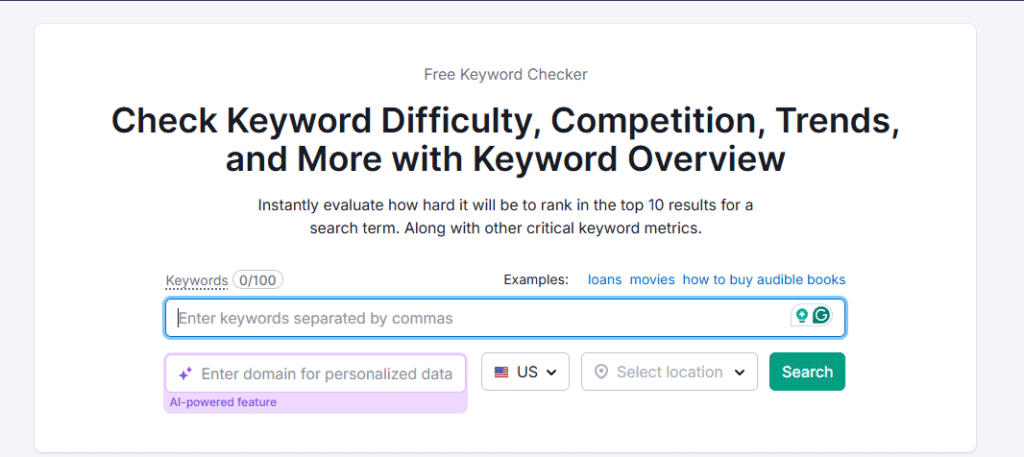
Let us understand the basics. Semrush’s keyword metrics, such as search volume, trend, and keyword difficulty, are the backbone of SEO research and content planning. The search volume metric represents the average number of monthly searches for a keyword, which is picked by Semrush from clickstream data, third-party tools, and Google API integrations.
Currently, Semrush has a keyword database of 25 billion keywords globally, which they regularly update to give their users accurate data. But is Semrush accurate with its keyword data?
On the other hand, the keyword difficulty score is calculated based on the number of authoritative domains currently ranking at the top of the search results.
It estimates how challenging it would be to rank organically for a given keyword. While these metrics are useful for finding the best keywords and evaluating competitiveness, it is important to remember that Semrush’s numbers are only estimates based on modelling and not fully accurate. They provide a solid directional guide for keyword targeting and SEO prioritization.
Typical issues: lag on trending terms, overestimation for low-volume keywords
Despite using advanced data modelling, Semrush overestimates and underestimates keyword volume sometimes for certain keywords. For example, for some keywords, Semrush might show less search volume data than the real data.
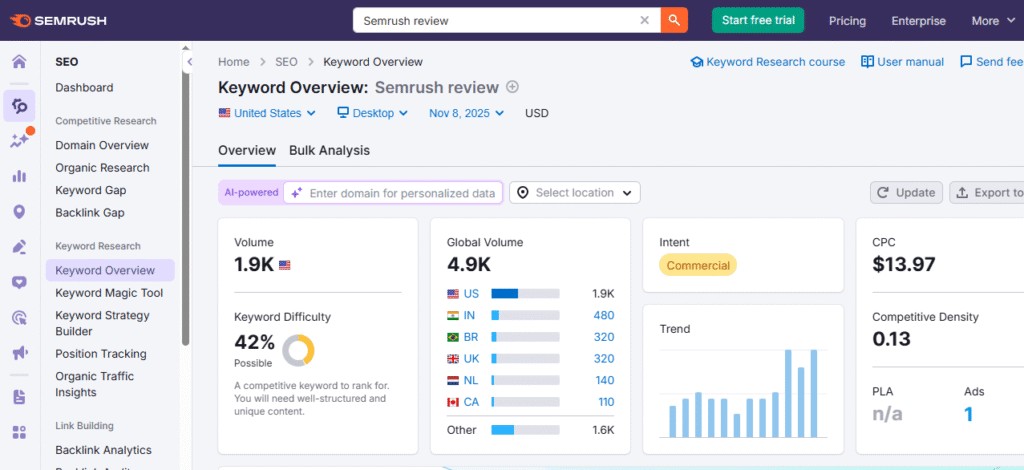
For example, for the keyword Semrush review, Semrush shows 4.9k traffic volume, while for the same keyword, Ahrefs shows a different search volume.
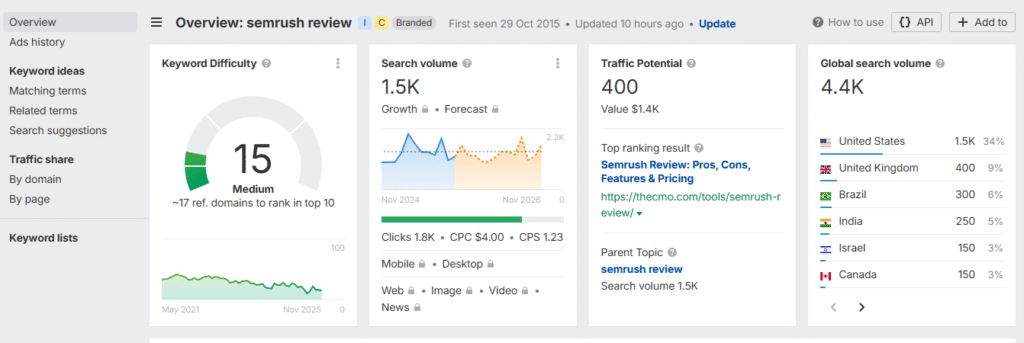
Ahrefs suggests a global volume of 4.4k for the same keyword. This clearly means that Semrush is overestimating for certain keywords.
This happens because Semrush keeps updating its keyword database monthly and quarterly depending on the region, sudden spikes, and level of competition. The tool not only overestimates but also underestimates search volume sometimes for keywords in niche topics. This happens when the model extrapolates from limited data samples.
So, is Semrush accurate for keyword research? The answer to this question is yes and no. SEO experts can use Semrush to find the best keywords for their business based on keyword volume and level of difficulty. However, they cannot completely depend on one single tool to make any decision.
Suggested test: compare SEMrush data with Google Ads and Google Trends
To know whether Semrush is accurate, we need to compare its keyword volume data with Google Keyword Planner and Google Trends.
For the same Semrush review keyword, Semrush is showing 4.9k per month volume.

Now let us check with Google Keyword Planner and Google Trends for the same keyword.

For the same keyword, Google Keyword Planner is showing the keyword volume data between 1 to 10k in the USA location and a low level of competition.
For this research, we can personally say Semrush is more accurate than Google Keyword Planner, as the latter only shows data for keywords and competition for paid search purposes.
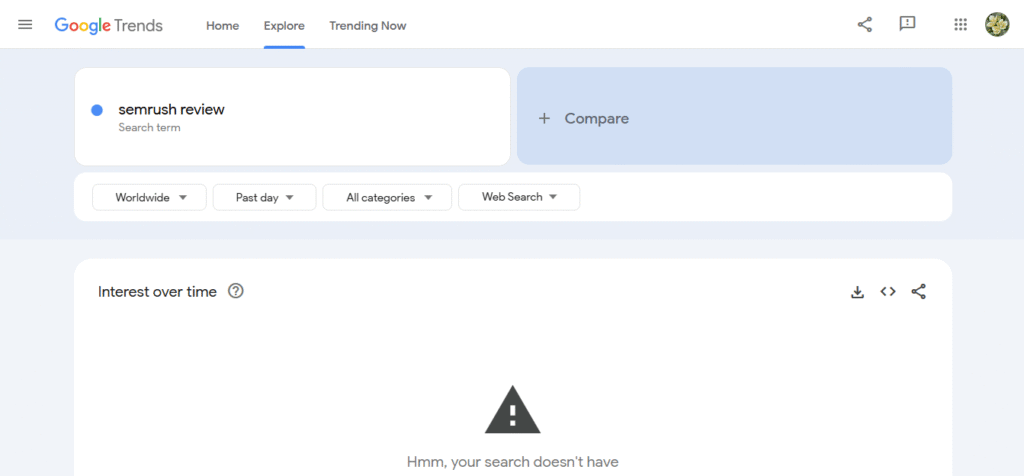
Unfortunately, we could not get enough data for the same keyword on Google Trends.
Conclusion: Based on our personal usage and experience, we can say that Semrush is accurate when it comes to keyword research, competition, and keyword search trends.
Explanation of Keyword Difficulty: Use it for prioritization, not precise difficulty
Semrush keyword difficulty is a metric that evaluates how competitive it would be to rank on Google for a particular keyword based on authority, backlinks required, and the content quality of top-ranking pages.
A high keyword difficulty of above 60% suggests that it would be hard to rank that keyword on top of Google, as many high-authority websites with good-quality backlinks might be dominating the rankings. However, a low KD should be treated as a relative indicator, suggesting that new websites can easily rank for low-KD keywords.
In practice, marketers should use SEMrush KD to organize keyword tiers, balancing quick wins (low KD) with long-term goals (medium-to-high KD). Combined with competitor analysis, this approach provides a smarter and more actionable SEO roadmap.
Visual: comparison chart for 10 sample keywords.
Keyword | SEMrush Volume | Google Ads Volume | Trend Direction (Google Trends) | SEMrush KD (%) |
AI Tools | 45,000 | 40,000 – 50,000 | Rising | 68 |
Link Building | 22,000 | 20,000 – 25,000 | Stable | 57 |
SEO Audit | 12,000 | 10,000 – 15,000 | Rising | 64 |
Guest Posting | 9,000 | 8,000 – 10,000 | Declining | 54 |
Digital PR | 7,500 | 6,000 – 8,000 | Rising | 52 |
Backlink Checker | 25,000 | 20,000 – 30,000 | Stable | 61 |
Content Marketing | 33,000 | 30,000 – 35,000 | Rising | 66 |
Keyword Research | 40,000 | 35,000 – 45,000 | Stable | 64 |
Blog Outreach | 4,500 | 3,000 – 5,000 | Slightly Rising | 49 |
PPC Tools | 15,000 | 12,000 –18,000 | Rising | 58 |
Backlink Data: Coverage and Differences
Overview of SEMrush’s backlink index and crawling frequency.
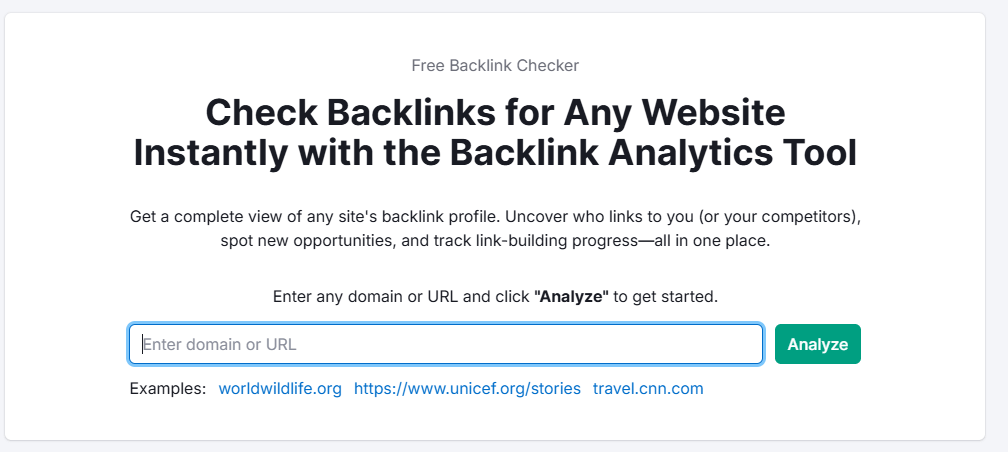
SEMrush is a great tool for checking backlink data of any website or landing page. It tracks billions of backlinks daily through the process of crawling and indexing, a process that search engines like Google follow. SEMrush’s crawlers scan new and existing web pages and check links pointing to different domains from the crawled webpage in real time. On average, SEMrush crawls and refreshes billions of backlinks every day to ensure its data remains up-to-date.
For our personal project, Rocket Ranker, we use SEMrush on a daily basis to check the number of new and lost backlinks.

Based on our personal experience, we came to know that SEMrush takes 1–2 working days to index any backlink of a website. For example, if you have built a backlink for your personal site, SEMrush might show it in its index or backlink analytics tool within 1–2 days.
That’s how quickly the crawlers of SEMrush work.
That’s not all.
SEMrush also provides detailed backlink insights such as the total number of referring domains, the type of backlink (nofollow or dofollow), the website URL from which the backlink is generated, and authority scores. A Pro plan user can also monitor link growth, spot spammy backlinks, and assess their site’s backlink profile against competitors.
How backlink counts differ across tools (Ahrefs, Majestic, SEMrush)
Different SEO tools have their own crawlers and bots for crawling and indexing backlink data, which leads to differences in the backlink count. We will understand this by taking an example of our personal website’s URL page and comparing its backlink count showing on SEMrush and Ahrefs.
We have taken the following URL: https://rocketranker.co.uk/upwork-reviews/upwork-vs-fiverr/
The SEMrush data for the following URL shows only one referring domain, which is not true.

We know that we have built a higher number of backlinks for the particular URL.
Now let us check with Ahrefs’ backlink data.

The Ahrefs data of backlinks for the above URL is more accurate compared to SEMrush.
SEMrush’s bots and crawlers might not yet have crawled and indexed all the backlinks and referring domains pointing to the above URL.
As a result, all SEO tools might show different backlink data. However, these differences don’t indicate inaccuracy; rather, they highlight each tool’s data collection priorities. SEMrush’s value lies in its contextual link data, helping users evaluate link quality, topical relevance, and the SEO impact of backlinks over time, rather than focusing solely on total counts.
Table: backlink/referring domain comparison for a sample site
SEO Tool | Total Backlinks | Referring Domains | Index Refresh Frequency | Primary Focus |
SEMrush | 1.2M | 10.4K | Daily | Quality + Trend Analysis |
Ahrefs | 2.0M | 12.8K | Every 15–30 Minutes | Link Depth & Freshness |
Majestic | 1.5M | 9.6K | Daily | Historical Trust Metrics |
When SEMrush backlink data is reliable (trend and quality analysis)
SEMrush data for backlinks is mostly used for analyzing trends and finding toxic backlinks on your website because other tools like Ahrefs and Majestic won’t give you data for toxic backlinks. Besides, SEMrush also has the upper hand in tracking new and lost backlinks, which helps users with outreach or PR efforts.
The SEMrush authority score is also a good metric because it is calculated by measuring the overall quality of a website, which includes backlink data, content quality, number of webpages, website design, and look and feel.
On the other hand, Ahrefs’ domain rating score is calculated only by the number of referring backlinks and domains pointing to a website.
Overall, SEMrush is a pretty good tool for tracking and monitoring backlinks of any website.
SERP and Rank Tracking Accuracy
Overview of SEMrush’s position tracking system
The rank tracking and positioning of keywords in SEMrush are shown very accurately, and we have personally witnessed its magic.
SEMrush provides rank visibility data, ranking trends, changes in position, new keywords ranking on SERP, image search results, keywords ranking in the People Also Ask section, keywords ranking for images, and everything that one requires to track their rankings and keywords on Google.
Users can also track their domain and compare it with their competitors, check ranking gains and drops, and segment the results by country or city. SEMrush collects the ranking data by scraping Google search for each targeted keyword.
The ranking reports are updated daily, and that’s why SEMrush shows new keyword rankings and position changes daily. This makes it an ideal tool for ongoing SEO monitoring.
Factors affecting ranking differences: location, personalization, and device
SEMrush ranking data is affected by many factors like location, personalization, and device type. For example, Google customizes its search results based on users’ behaviour, search history, and geographic location, while SEMrush provides a generalized overview of the ranking of keywords.
The type of device—mobile or desktop—also affects the ranking, as the algorithm gives different preferences for different types of devices. Moreover, location-based search intent, for example, “near me” queries, can change the results dramatically between cities and states.
SEMrush minimizes these differences by allowing location-based tracking, but users should expect slight ranking fluctuations when comparing its data to live Google searches performed on personal accounts.
Suggested manual test: compare SEMrush ranking with live Google results
If you really want to know whether SEMrush is accurate, then you must compare the rankings on SEMrush with Google for the keywords.
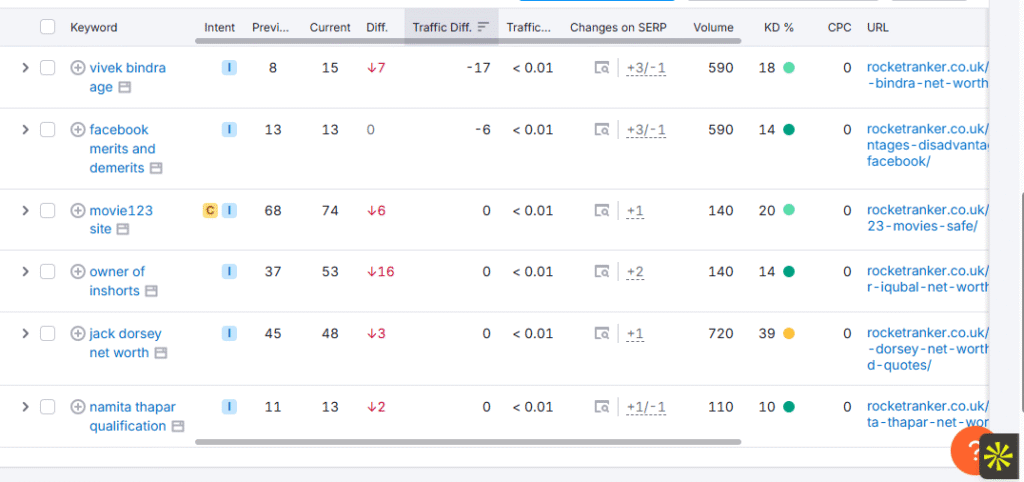
The keywords showing in SEMrush have shown some loss in rankings. Now we will check and confirm their Google rankings.
For the keyword Vivek Bindra age, our website is ranking in the 12th position on Google, which is nearly accurate.

For the keyword Facebook merits and demerits, our website is ranking in the 17th position.
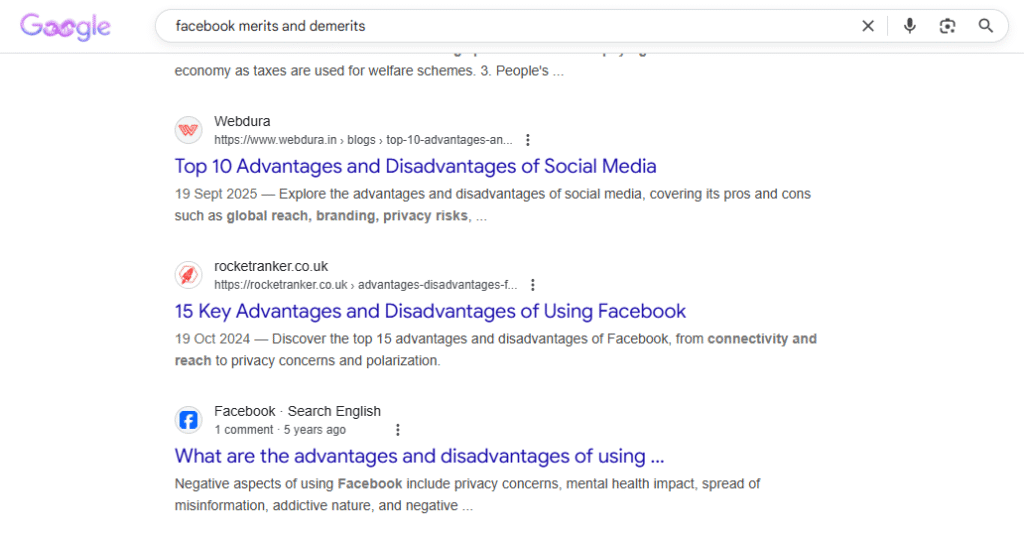
This is also nearly accurate.
Hence, we can conclude that SEMrush does show accurate rankings and positioning of keywords.
Other SEMrush Tools and Their Accuracy
Content Audit, On-Page SEO Checker, and Topic Research — what they’re good for
If you really want to know if Semrush is accurate, then you need to try the other Semrush tools as well. Semrush offers other supporting tools beyond keyword research and backlink analysis.
It offers a content audit toolkit, on-page SEO checker, technical SEO checker, AI content assistant, and more. The content audit toolkit will help you plan the content outline for your website by analyzing the top-ranking content on Google.
The on-page SEO checker will check all the on-page SEO factors of your site like title tags, meta tags, image tags, and a lot more, and will give you suggestions. Overall, all these tools are accurate and give correct information about the site.
Explain that these use heuristic scoring and NLP models
Most of Semrush’s content-related tools use heuristic scoring systems and NLP (natural language processing) modules. These technologies check the context of the content, text structure, keywords, and semantic relevancy, and then give better suggestions on how users can improve the overall on-page SEO of their site.
For example, the on-page SEO checker leverages machine learning to compare on-page factors with top-ranking pages from Google, while the content audit tool assesses engagement metrics and link depth.
Good for guidance and ideation but should be reviewed manually
If you are still wondering if Semrush is accurate, then let us tell you that yes, it is. While Semrush does offer some accurate and amazing insights about a website and gives suggestions to level up your SEO, the suggestions should still be reviewed manually.
For example, if you are doing a backlink analysis of your own website, then you should cross-check the data from Google Search Console. Or, if you are doing keyword research, then you should review the search volume and competition from Google Keyword Planner.
Known Biases and Common User Complaints
Overview of known limitations: overestimation bias, update lag, smaller keyword set in some regions.
Semrush has a few drawbacks like overestimation and underestimation in traffic and keyword search volume data. These issues arise from its reliance on sampling and data scraping techniques. Despite these cons, Semrush is accurate and remains a top SEO tool for trend analysis and comparative SEO insights.
Summary of user reviews and comparison studies
Here is the snapshot of some user reviews of Semrush from Trustpilot.

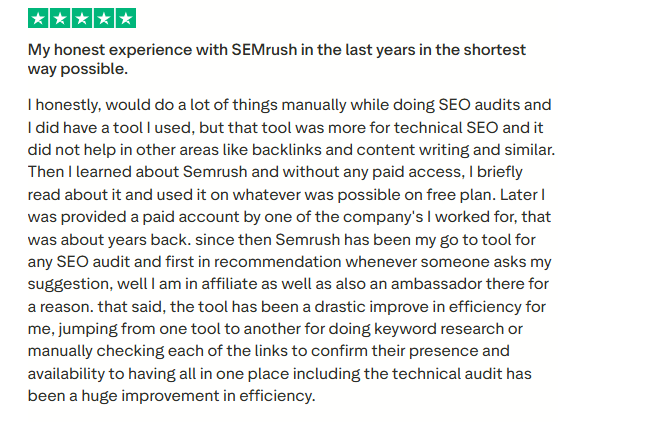
Emphasize that SEMrush should not be used as a system of record but as a comparative tool
SEMrush should be treated as a comparative analytics platform, not a system of record. Its value lies in showing relative performance, keyword gaps, and market direction, not in delivering exact numbers. For precise data, marketers should verify metrics using Google Analytics, Search Console, or other first-party analytics platforms.
FAQs: Is SEMrush Accurate?
No, SEMrush provides estimates accurate for trends, not exact figures.
Because it uses sampled clickstream data, not direct analytics.
Yes, it’s reliable for identifying trends and competition levels.
Quite accurate for trends and link quality, though totals may differ from Ahrefs.
Use it as a comparative SEO tool, not as a primary data source.

